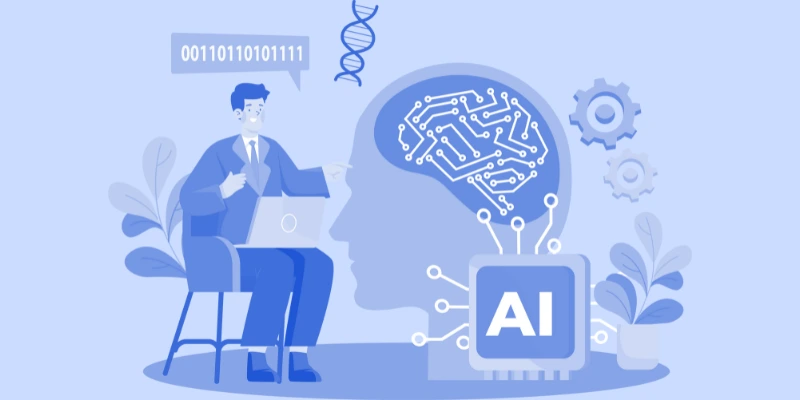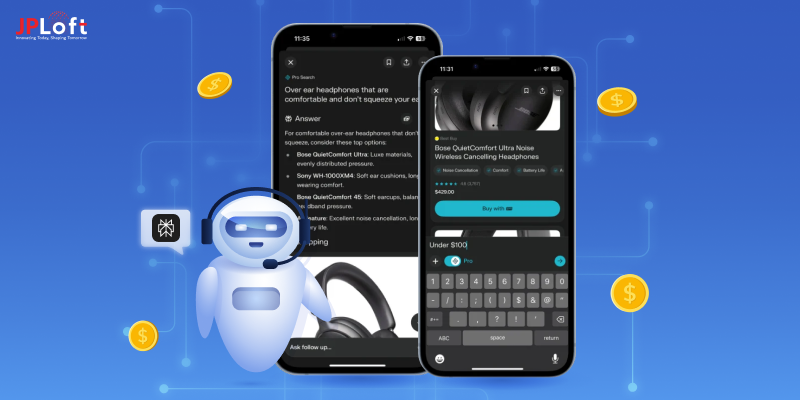In 2025, developing an AI model will turn out to be a key factor of technological innovation since organizations from all sectors will begin applying the technology to resolve complex issues, automate effective processes, and satisfy users' unique needs. The development of Artificial Intelligence models hinges critically on the fact that this is a service that involves aiding the clients by providing appropriate skills, technology, and infrastructure to create the specific AI system needed. It does not matter if it is predictive modeling, speech-to-text, or vision systems; the process of AI model development involves knowing the basics of machine learning algorithms, how to handle raw data, and how training can be applied.
The process of implementing an AI system usually starts with problem formulation, followed by data collection and preparation, algorithm selection, and, finally, an iterative training and tuning process to maintain the required level of performance. Since the trends of artificial intelligence surge in business enterprises, organizations have begun to delegate these processes to competent AI model development groups since they can hasten the processes while upholding performance and efficiency.
In this article, we will provide a step-wise process for creating AI models and discuss aspects such as selecting the appropriate AI development services, becoming familiar with important technologies, and realizing the AI project in question from the perspective of meeting business needs. Whether we are talking about a startup or an already well-established company, learning effective design and implementation of AI models is very important in the present day and age.
What is an AI Model?
Artificial Intelligence, or AI model, is an advanced computer program generated to handle activities such as reasoning, problem-solving, and learning that are actually meant to be managed by a human brain. Big datasets are employed to train the models so they can recognize trends, frame intelligent decisions, and forecast outcomes without any human interruption. AI models can estimate valuable results for different apps, ranging from predicting financial aspects and autonomous driving to Natural Language Processing (NLP) and recognizing pictures.
There are a lot of stages included in designing an AI model, like data collection, training, preprocessing, validating, and model deployment. By adjusting parameters at the time of training, the model lowers the chances of accounting errors by studying the data deeply. The technique used to build an AI model can change, and this variation is determined by whether it is inspected, uninspected, or leverages reinforcement learning.
Types of AI Model
Three main categories of artificial intelligence (AI) models—Artificial Narrow Intelligence (ANI), Artificial General Intelligence (AGI), and Artificial Superintelligence (ASI)—represent various degrees of machine intelligence. Each of these models demonstrates a different set of skills regarding its ability to affect multiple industries and sectors of society.
Artificial Narrow Intelligence (ANI)
The terms “Weak AI” and “Artificial Narrow Intelligence” both refer to carrying out a practical task within a certain area. At present, it is the most widely applied form of AI seen in applications such as virtual intelligent voice assistants (Siri, Alexa), recommender systems, chatbots, and image classifiers, amongst many others. These systems are very good at addressing specific issues; however, they cannot perform activities beyond their particular focus. Typically, ANI models that serve the specific needs of the given industry are designed by AI app development companies. Such specialization offers companies the capability to advance processes or improve interactions with consumers using AI development services.
Artificial General Intelligence (AGI)
Artificial General Intelligence, commonly known as Strong AI, pertains to an advanced version of computer-simulated intelligence that could match the average human intelligence. It would be possible to design AGI systems where they can acquire information, comprehend it, and then execute a task in any particular domain, very similar to how a person thinks. As AGI is mostly theorized, an AI development company may develop AGI-oriented prototypes where the focus may exclusively be on human intelligence logic, making decisions, and learning. Such models would represent a qualitative development of AI models with a number of applications that have never been seen before, especially in health care, schooling, and machines.
Artificial Superintelligence (ASI)
In all areas, including creativity, emotional intelligence, and problem-solving abilities, artificial superintelligence surpasses human intellect. By offering superhuman-level solutions to challenging global problems, this imaginary stage of AI might revolutionize industries and civilizations. As its abilities may exceed human understanding, ASI also presents ethical questions regarding safety and control. Even though the idea of ASI is still a ways off, businesses that offer AI development services are always coming up with new ideas to push the limits of the technology and set the stage for much more in the future.
Prerequisites to Consider Before Creating an AI Model
More than just technical expertise is needed to build a successful AI model; it also takes a planned and strategic approach from the beginning. Setting up the foundation correctly is essential for long-term success, regardless of whether you're an AI app development company or a company wishing to use AI development services. Let's examine the main requirements you should take into account before starting to design an AI model.
-
Clear Identification of Problem
The first step is distinguishing the problem your AI model will solve. It may be improving customer satisfaction, automating certain duties, or even pattern recognition, but with an objective, it may be easier to do something. As an AI firm, it is always good to ensure that this is also in line with business goals so that your work pays off.
-
Data plays a critical role
The foundation of every artificial intelligence or machine-based system is quality data. High-quality training data is very important for the model build, and thus, it is a key point to collect, clean, and process it. The truth, however, is that too much or too little information results in poor-performing AI outputs, which is why data management comes first in an AI development company’s primary tasks.
-
Select Appropriate Tools
Proper tool selection, such as Tensorflow or Pytorch, is crucial to the project's success. Make sure that the technical stack you use can sustain the current AI model and enhance it in the future. Keeping pace with AI technology and services will ensure that your models will perform effectively in the competing and fast-changing world of AI.
-
Commit to the Hiring of Talented Individuals
A talented group of data scientists, domain specialists, and developers is needed to create a successful AI model. Having the correct balance of personnel guarantees that the AI solution is both technically competent and in line with business goals, whether it is developed internally or through AI development services.
-
Consider Ethical and Compliance Considerations
Ethical AI is the need of the hour in 2025. It is important that you address biases and privacy issues, keep everything open to establish confidence, and ensure that the process of your AI model development is within the law.
If you can identify these areas, you will be able to design and implement a strong AI model that will serve current or future needs.
How to Generate an AI Model?
Designing an AI model can be transformative for businesses. It makes processes easier, strengthens decision-making, and encourages imagination. It doesn’t matter whether you own an AI app development company or are seeking to create your own AI solution; the key to victory is taking a systematic approach. Below are the main steps involved in building an AI model:
Select a Suitable Framework
The right framework or platform must be chosen before beginning the process of creating an AI model. Popular frameworks like TensorFlow, PyTorch, or AutoML tools make building, training, and deploying models easier for AI development businesses. Your decision should be based on the project objectives, team experience, and model complexity. When using AI development services, it's critical to make sure the platform is scalable and easily connects with the current setup.
Gathering and Preparing Data
Any model of artificial intelligence runs on data. To start, collect a rich and diverse dataset related to the issue you are trying to solve. After being gathered, data needs to be preprocessed and cleaned to get rid of errors or inconsistencies. To make sure the data is prepared for model training, this involves normalizing, classifying, and organizing it. You can make sure that this process is done effectively, reducing errors and increasing model accuracy, by collaborating with an AI development company.
Choosing the Accurate Algorithm
The upcoming step is choosing the algorithm that is compliant with the AI model. Depending on the kind of task (e.g., classification, regression, clustering), algorithms like decision trees, neural networks, or support vector machines are frequently utilized. Your AI model development will only be successful once you select the appropriate algorithm since this will have a direct impact on the model's capacity to learn from data and provide predictions.
Train the Model
When you train the model, your AI gains knowledge from the data. As soon as the algorithm receives the training dataset, the model begins to identify links and patterns. AI development businesses use optimization techniques, gradient descent, and backpropagation for complex projects to make sure the model predicts outcomes appropriately. To avoid overfitting or underfitting, this stage also entails dividing the data into training and validation sets.
Assess and Fine-Tune the Model
The model must be tested after training to determine its performance. F1 score, recall, accuracy, and precision are examples of common measures. To increase the model's efficacy, fine-tuning may entail changing the algorithm, retraining using fresh data, or modifying its parameters. Based on these variables, an AI app development company can assist in optimizing models for maximum performance.
Model Deployment
Deployment is the last stage in developing an AI model. Integrating the model into one's system or application is imperative to allow the model to start making real-time decisions. On-premises, cloud, or edge deployment notwithstanding, companies need to guarantee that the model is robust and maintains a continuous inflow of new data. AI development services may include continuing upkeep to track results and make required modifications over time.
Essential Trends in AI Model Development in 2025
As artificial intelligence continues to advance, a new wave of developments is emerging in 2025 that are changing the way that AI model development is done. These trends, which range from innovative automation technologies to moral AI practices, are crucial for any organization using AI development solutions or for any AI development company. Let's examine a few of the major themes propelling AI progress.
Explainable AI (XAI)
In 2025, there will be a greater need for transparency in AI models than ever before. One aspect of AI that is becoming more popular is Explainable AI or XAI, which deals with designing models that make sense to the user. This is critical for organizations that are trying to win confidence from users and regulators. To reduce the black-box effect of AI decision-making and improve user trust, an AI application development company may tap into the concept of XAI to create easily understandable processes.
AI for Sustainability
Sustainable AI model design is becoming increasingly common. Building large models requires a lot of computational power, disturbing the balance of the ecosystem. In 2025, organizations dedicated to AI and related technologies will start practicing green policies and developing energy-optimized algorithms. The effectiveness of AI applications will be in line with the responsible use of the environment.
Bias Mitigation and Ethical AI
As AI becomes engrossed in day-to-day life applications, handling ethical issues is a must. Today, removing bias from models is a major priority for AI development businesses in order to ensure equitable and responsible use. AI development services are increasingly providing ethical AI techniques that take into account data privacy, justice, and societal impact in order to prevent unexpected outcomes and increase customer trust.
AutoML
The introduction of AutoML has brought several changes in the deployment of AI models. It has mechanized several processes, such as data preparation, model selection, tuning, and many other complex, labor-intensive processes. There is a shift towards non-technical people using AI, which is shortening the software development cycle for businesses. In the case of an AI app development company, AutoML implementation helps reduce project timelines, thus making the development of AI applications more economically viable.
Think of Real-Time AI
In 2025, the ultimate focus is real-time AI processing. AI model development is moving toward immediate, real-time solutions, whether for dynamic decision-making systems or AI-driven customer care. AI models that can process and respond to data in real-time, enabling speedier and more interactive applications, are becoming increasingly necessary for businesses.
Obstacles in AI Model Development
Even though developing AI models has great promise, there are challenges. Businesses and developers must comprehend these obstacles before starting the process of creating reliable AI models. Overcoming these challenges head-on is essential for success, regardless of whether you run an AI app development company or a company that uses AI development solutions.
Data-Associated Problems
The effectiveness of an AI model is determined by the quality of the data it trains on. Compiling enough suitable samples of data is usually one of the hardest hurdles that most firms that build AI models face. Artificial Intelligence relies heavily on vast amounts of data; however, companies often have to deal with misaligned or twisted sets of data. At this point, data scrubbing and data preprocessing become imperative features that require a lot of time and skill from a seasoned AI development company.
Underfitting and Overfitting
Balance is crucial when it comes to training AI models. When a model performs remarkably well on training data but is unable to generalize to new data, this is known as overfitting. Conversely, underfitting results from a model that needs to be revised to identify the underlying patterns in the data. Both problems result in imprecise outcomes and poor execution in practical settings. To achieve the ideal balance, cross-validation procedures, regularization strategies, and effective model tuning are crucial.
Bias and Ethical Concerns
As AI model development advances, concerns over moral usage also apply. Data bias can produce biased AI models, which can produce unfair results. A responsible AI development business must take precautions to reduce these dangers by guaranteeing varied, representative datasets and implementing fair algorithms. Building models that are both successful and socially responsible requires ethical AI, which is no longer a secondary concern.
Elevated Computational Prices
It is well-known that training AI models consume a lot of computing resources, especially deep learning models or those that have to wade through a lot of data. The cost associated with the required hardware, such as GPUs or TPUs, and the energy used may be high, especially for companies that still need to set up AI-dedicated systems. This is where AI Development Services come in handy in providing flexible options, from training on the cloud to using ready models in order to reduce costs.
Managing Rapid Innovation
The field of artificial intelligence is developing quickly. It's difficult for even the most senior engineers to keep up with the rapid advancement of new tools, frameworks, and algorithms. Businesses offering AI development services must spend money on continuing education and skill development to stay competitive in this rapidly evolving field.
Interoperability of Model
The need for explainable AI (XAI) is rising as AI enters more industries. Companies that use AI models should be aware of the decision-making process, particularly in fields where accountability is critical, such as law, healthcare, and finance. However, many AI models, particularly deep learning models, behave like black boxes, making it challenging to interpret their results. Innovative methods, including building simpler models or transparent frameworks, are needed to solve this.
Also Read: Cost To Build Artificial Intelligence Project 2024 - AI Pricing
In a Nutshell
Creating AI strategies in 2025 is a paradigm shift with great possibilities for organizations within every sector. Ranging from aiding in decision-making to executing certain processes and providing bespoke solutions, AI models have become inevitable to successful competition in the current era that is slowly but surely going digital. Nonetheless, in order to fully tap into the potential of artificial intelligence, businesses have to address issues related to the quality of data, ambitions versus ethical integrity, infrastructure monetary requirements, and confidentiality.
Choosing adequate software, employing skilled personnel, and complying with ethical and privacy policies allow organizations to create effective and unnecessary AI models. In addition, innovative AI techniques such as Explainable AI, AutoML, and real-time processing, among others, will enhance the future prospects of AI model development.













Share this blog